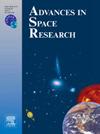Fragmentation characterization in the circular restricted three body problem for cislunar space domain awareness
IF 2.8
3区 地球科学
Q2 ASTRONOMY & ASTROPHYSICS
引用次数: 0
Abstract
With heightened international interest in spacecraft activities in the vicinity of the Moon, cislunar space debris is likely to follow. Even one fragmentation event can have catastrophic and far-reaching consequences, which drives the need for appropriate debris characterization tools. How a single fragmentation plays out is highly dependent on any given initial condition in the near-chaotic cislunar region. This paper offers a means of structuring the cislunar region in terms of dynamical flow, which enables global characterization of fragmentation events without propagation of every possible case. This work investigates patterns in fragment behaviour as a function of energy, , and orbit location, and explores emergent dynamic structures in the vicinity of the Earth-Moon Lagrange point. Subsequent findings are applied to analysis of a realistic breakup event for a 500 kg satellite on an Lyapunov orbit with a Jacobi constant of 3.0165, modeled using an in–house modified version of the NASA Standard Breakup Model.
环形受限三体问题中的碎片特征,用于顺星空间域认知
随着国际社会对月球附近航天器活动兴趣的增加,半月空间碎片也可能随之而来。即使是一次碎裂事件也会造成灾难性的深远影响,因此需要适当的碎片特征描述工具。一次碎裂事件的结果如何,在很大程度上取决于近混沌半月区域的任何给定初始条件。本文提供了一种从动态流的角度来构建顺行星区域的方法,从而能够在不传播每一种可能情况的情况下对碎裂事件进行全局描述。这项工作研究了碎片行为作为能量、Ⅴ和轨道位置函数的模式,并探索了地月拉格朗日点附近出现的动态结构。随后的研究结果被应用于分析一颗重 500 千克的卫星在雅可比常数为 3.0165 的里亚普诺夫轨道上发生的现实破裂事件,该事件是使用美国国家航空航天局标准破裂模型的内部修正版进行建模的。
本文章由计算机程序翻译,如有差异,请以英文原文为准。
求助全文
约1分钟内获得全文
求助全文
来源期刊

Advances in Space Research
地学天文-地球科学综合
CiteScore
5.20
自引率
11.50%
发文量
800
审稿时长
5.8 months
期刊介绍:
The COSPAR publication Advances in Space Research (ASR) is an open journal covering all areas of space research including: space studies of the Earth''s surface, meteorology, climate, the Earth-Moon system, planets and small bodies of the solar system, upper atmospheres, ionospheres and magnetospheres of the Earth and planets including reference atmospheres, space plasmas in the solar system, astrophysics from space, materials sciences in space, fundamental physics in space, space debris, space weather, Earth observations of space phenomena, etc.
NB: Please note that manuscripts related to life sciences as related to space are no more accepted for submission to Advances in Space Research. Such manuscripts should now be submitted to the new COSPAR Journal Life Sciences in Space Research (LSSR).
All submissions are reviewed by two scientists in the field. COSPAR is an interdisciplinary scientific organization concerned with the progress of space research on an international scale. Operating under the rules of ICSU, COSPAR ignores political considerations and considers all questions solely from the scientific viewpoint.
 求助内容:
求助内容: 应助结果提醒方式:
应助结果提醒方式:


